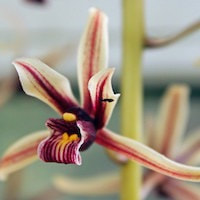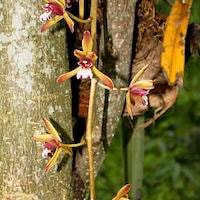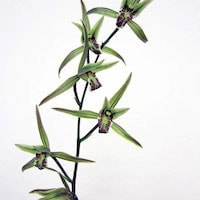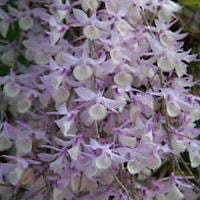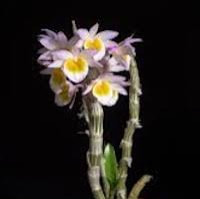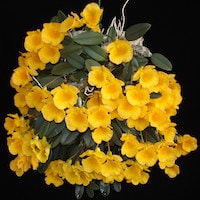WC8 - Women's Citrus 8 - Midnight's summer dream
|
Native Singaporean Orchid notes: Hoya imperialis
The Hoya imperialis is known for its large, stunning flowers that turn a beautiful pink color with a white center. Sometimes, even the center can have a touch of pink. This plant blooms frequently, bringing joy when its flowers open up. It's best to plant Hoyas in smaller pots to encourage more blooms early on. Orchid lovers should keep temperatures above 60°F for optimal growth. The Hoya imperialis grows remarkably fast, reaching heights up to 30 feet in just 18 months. Its flowers release a captivating fragrance in the evening, reminiscent of Neroli, which is strong and enchanting, making it truly remarkable.
|
Therapeutic Orchid notes:
|
Cymbidium aloifolium (L.) Sw. Syn. Cymbidium pendulum (Roxb) Sw.
Cymbidium aloifolium, known by various names across Asia, has medicinal properties attributed to its chemical compounds like aloifol I and II. It's used in Indian traditional medicine for treating inflammation, pain, and various ailments. In different regions, such as Orissa and Tamil Nadu in India, it's called Supurn and panaipulluruvi respectively, while in Myanmar, it's known as Thit tet lin nay. Tribes like the Konda and Koya in India use its roots to treat foot cracks and fractures. In Karnataka's Kudremukh National Park, locals use its leaf mucilage to stop bleeding from leech bites. This orchid species serves both medicinal and cultural purposes across Asia. |
|
Cymbidium finlaysonianum Lindl.
Cymbidium finlaysonianum, known as sepuleh in Malay and Ka Re ka Ron Pak Pet in Thai, contains phytochemicals like vitexin and isovitexin. In traditional Malay medicine, it's used for its "restorative" properties, believed to remove bewitchment and restore health. This orchid is historically significant in Telok Anson, northwest Peninsular Malaysia, where local medicine men have employed it for healing purposes. Its cultural and medicinal roles highlight its importance in traditional practices across Southeast Asia. |
|
Cymbidium kanran Makino
The frigid Cymbidium orchid, also known as winter orchid or grass orchid locally, is highly esteemed among Chinese cultivators for its beauty and fragrant blooms. It typically flowers from August to January, with peak bloom in December and January. In traditional Chinese medicine, practitioners use the entire plant, sourced from regions like Huadong, Huanan, and Yunnan, for various medicinal purposes. It's employed to cleanse the heart, soothe the lungs, and alleviate conditions like coughs and asthma. The roots of this orchid are specifically used to treat gastroenteritis and parasitic infections like ascariasis. |
|
Dendrobium aphyllum (Roxb.) C.E.C. Fisch, syn. D. macrostachyum Lindl.
This species of orchid is found across continental Southeast Asia, extending into southwest China, Sikkim, and Nepal. In traditional herbal practices, it's known by various Thai names like Uean sai and Ueang yumai. In Nepal, the stems are used to create a tonic, while the Valmikis tribe in Andhra Pradesh uses the juice from young pseudobulbs to prepare eardrops for treating earaches. Additionally, dried stems are utilized as a herbal remedy known as shihu, reflecting its diverse medicinal uses across different cultures. |
|
Den crepidatum Lindl. & Paxton
The rose Dendrobium, known as Meigui Shihu in Chinese and Uang sai nam khieo in Thai, contains alkaloids like crepidine, crepidamine, and dendrocrepine. In Traditional Chinese Medicine (TCM), its stems are used to nourish yin, improve stomach function, and relieve throat dryness. In Nepal, these stems are utilized for treating fractures. Among the Hani people in Yunnan, China, it's valued as one of 199 medicinal plants they use, cultivated in home gardens alongside wild plants gathered from forests. This orchid holds significant medicinal importance across diverse cultures in Asia. |
|
Dendrobium jenkinsii Wall. ex Lindl.
The orchid known as Ueang phung noi in Thai and Yadanar shwe ket lay in Myanmar is a miniature species found from the eastern Himalayas to Myanmar, Thailand, southern Yunnan, Laos, and Vietnam. In traditional herbal medicine, it is used similarly to other orchids as shihu. This suggests it is valued for its medicinal properties across these regions, although specific details about its uses in herbal medicine beyond being categorized as shihu are not provided in this summary. |
Other scent note
Top of Quince, sweet orange blossoms, yuzu, and kumquat; middle notes of juniper, Mediterranean fan palm and lemon, tea
Scentopia Library Reference ingredient
Grape - Check details at Scentopia's scent library
Download the guided mediation that works best with this Orchid fragrance oil
| women_citrus_essential_oil_orchi_00008.mp3 | |
| File Size: | 114434 kb |
| File Type: | mp3 |

